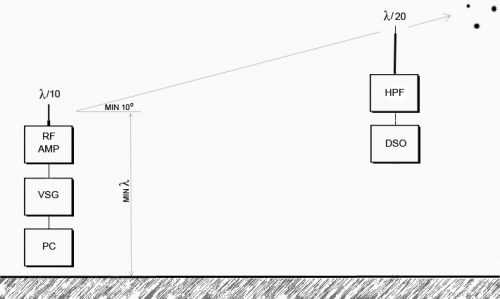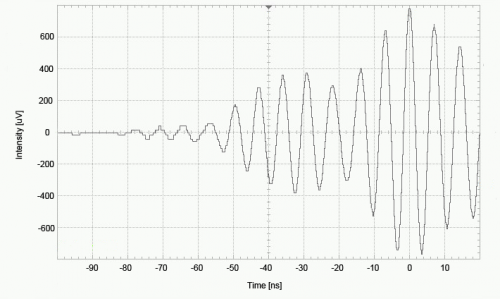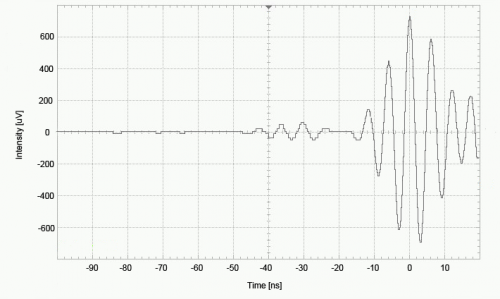

Darko
Members-
Posts
7 -
Joined
Content Type
Profiles
Forums
Events
Everything posted by Darko
-
Last summer I tried to detect advanced waves at longer distances, but I found that I can’t detect anything but noise in the advanced time window even at short distances, at usual elevation angles. The advanced signal was only detectable at high elevation angles closer to the zenith. The graph below shows measurements in the advanced time window at a distance of 4 m (λ/4 TX ant. and λ/20 RX ant.) at an angle of 25 ᵒ. Each data point is the average of 1000 pulses (6 ns FWHM, 250 MHz, 10 dBm CW) and the error bar is the standard deviation of the mean. Measurements were conducted from August 21, 2017 to November 21, 2017, every day at 12:00 UTC. The gap in the graph represent period where no measurements were conducted. Possible reason for this (under the hypothesis of advanced waves) may be a significant difference in the amount of water in the troposphere in summer and winter. For example, in January 2017, mixing ratio measured in the local radiosonde station at 925 hPa was around 2g/kg, and in August 2017 around 10g/kg. Moreover, the occurrence of super-refraction is common in summer on the coast of the Adriatic Sea, so the EM wave bends toward the ground instead of continuing upward to free space. During the measurements near the zenith I noticed that the advanced signal is stronger than the retarded one, when the receiving antenna is further shortened below the length of λ/30. This is actually in line with Hogarth's calculations in the Wheeler-Feynman absorber theory for an open, ever-expanding universe. The transmitting antenna radiates predominantly advanced electromagnetic waves into free space when there is no interaction with the instrument of observation or some other absorber in the environment. In other words, the electromagnetic arrow of time points in the direction of the past when there is no interaction (except the interaction with an absorber in the distant past), and the observation/interaction reverses the direction of the electromagnetic arrow: http://philsci-archive.pitt.edu/13505
-
This should be an easy read: https://arxiv.org/abs/1510.06712 Also, videos of the 2014 Retrocausality Conference in University of Cambridge: https://www.youtube.com/channel/UC4JIEAfu0friyN-DfwmC_Zw
-
Yes, I know that a long coax cable run can cause pre-echo ghosting, so I used a very short cable (about 12 cm long). I also tested this without a cable, just with a piece of short wire directly connected to the antenna input.
-
I found a simpler and cheaper way to detect advanced waves. In the configuration as shown in Figure 1, instead of a RF signal generator, an analog VHF TV transmitter of about 100mW can be used, and instead of an oscilloscope, a portable analog TV receiver can be used. If the antennas are spaced more than about 22 meters (corresponding to the signals arrival time difference of about 147 ns), the “advanced ghost image” shifted to the left from the “retarded image” (which means earlier in time) should appear. The first PAL TV (on ch E5, 175.25 MHz) image below was received with a λ/4 whip antenna. An efficient receiving antenna of the appropriate size (e.g. a λ/4 whip antenna) acts as an absorber whose advanced waves cancels out the advanced waves emitted from the transmitting antenna, and therefore only the image that comes with retarded waves is visible. The second image was received with a λ/24 antenna (a piece of copper wire long about 7 cm) in the same place. This antenna is a much weaker absorber, so it fails to completely cancel out the transmitter advanced waves, and therefore both images are visible (retarded and advanced, which is weaker and shifted to the left).
-
For a SF story you can use advanced waves from the Wheeler-Feynman absorber theory: https://en.wikipedia.org/wiki/Wheeler%E2%80%93Feynman_absorber_theory According to the WF theory, if electromagnetic radiation of a certain wavelength is not completely absorbed by the matter of the universe, than some amount of advanced waves could be detected before their emission. With advanced waves you can have instantaneous communication at a distance which is in conformity with relativity since all interactions take place at the speed of light. Earth-Mars communication with advanced waves, when they are separated by 20 light minutes, would go like this: A Message sent from Earth at 12:00 will arrive at Mars by advanced waves at a time 2r/c before the arrival of the retarded wave (12:20). Hence it will arrive at 11:40. The response from Mars will arrive at Earth by retarded waves 20 minutes later, at 12:00, therefore instantly. By advanced waves it will arrive at Earth at 11:20, 40 minutes before first message is sent.
-
Hi, I recently performed an experiment similar to the Schmidt (1980) experiment, and unlike Schmidt, I got something that looks like a positive result, but only after numerous unsuccessful attempts. This is part of the abstract of the Schmidt (1980) paper; A Search for Advanced Fields in Electromagnetic Radiation: An experiment to search for an advanced component of electromagnetic radiation, as suggested by the time symmetry of Maxwell's equations was conducted. A dipole transmitting antenna was driven periodically with 10.2 GHz microwave pulses of 12 ns duration and 4 watt instantaneous power. A receiving dipole antenna at a distance R = 10m away was instrumented to search for power above noise received in a time gate at a time r/c prior to transmission of each pulse. Data were integrated over 10 to the 7th power pulses. The experiment was performed at Lick Observatory, atop Mt. Hamilton, CA, to enable placement of the antennas so that a line connecting them, when extended to infinity in both directions, encounters no local complete absorber. In the Schmidt experiment configuration I also got negative results. After at least 2000 runs in which no statistically significant signal above the level of the noise were detected in the advanced time window, I introduced three important changes in the experiment. The positive result was obtained only when all three changes are implemented simultaneously: 1. The experiment is carried out at wavelengths greater than 21 cm. It is possible that, due to the red shift in the distant future, microwaves of shorter wavelengths become stretched to the wavelength of 21 cm and absorbed by interstellar hydrogen, as suggested by Fearn (2014). 2. The detection is done with a λ/20 antenna, as suggested by Niknejadi (2015). The advanced signal disappears when antenna of ≈λ/6.7 or bigger is used for detection. 3. The antennas are placed so that a line connecting them, when extended behind the receiving antenna, points to the sky at an angle of ≈10° above the horizon. The advanced signal disappears in conditions of high relative humidity of the air and overcast sky at angles of less than ≈5°. Even though the SNR of the signal measured in the advanced time window defined as μ/σ reaches 30.9, the possibility that the real cause of the signal is an unknown source of systematic error cannot be completely ruled out. If perhaps someone is interested to reproduce the experiment to confirm or refute the results, here can find more details about the experiment: Measurement of Advanced Electromagnetic Radiation - http://doi.org/10.5281/zenodo.247283 From the above working paper: The block diagram of the basic experiment is shown in Figure 1. RF signal generator Signal Hound VSG25A generates pulses in duration of 6 ns to 24 ns (FWHM) and 10 mW (CW) power. Signal is supplied with an 8 cm long coaxial cable to the RF amplifier Mitsubishi M57796MA from which the signal amplified to ≈100 mW (CW) is supplied to a λ/10 monopole transmitting antenna, placed 200 cm above the surrounding terrain. At a distance of 430 cm, a receiving λ/20 monopole antenna is placed at the height of 300 cm above the ground. Angle between the horizon and the line connecting the two antennas is ≈10°. Received signal is supplied by 60 cm long coaxial cable through simple high pass filter to 50Ω input of 300 MHz oscilloscope Rigol DS2302A and a 100 MHz wide digital band-pass filter is applied to the signal. Horizontal scale is set to10 ns/div, vertical scale is set to 500 μV/div, while the mathematical scale in which the filtered signal is shown is set to 200 μV/div. Fig. 1 Figure 2 A shows a signal measured in the above described configuration at an angle of ≈10°. Peak of the retarded pulse, 12 ns FWHM, wavelength of 167 cm is at 0 ns. Peak of the advanced signal is at -28.6±0.2 ns. Average value (Vrms) of advanced signal after 1000 pulses is 252.3±9.5 μV. Error is the standard deviation. As shown in Figure 2 B, by raising the transmitting antenna by 50 cm and thereby by reducing the angle to ≈ 3.5°, the advanced signal weakened to 35.4±5.1 μV. Runs were made 5 minutes apart at clear skies and low relative humidity. Same effect can be achieved by lowering the receiving antenna to the height of the transmitting antenna. In conditions of high relative humidity of the air or cloudy weather, the signal completely disappears at angles smaller than ≈5°. Fig. 2A Fig. 2B I'm not a professional physicist (obviously), so it is possible that I made some big mistake that I did not aware of. Any criticism is welcomed and appreciated.




